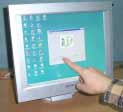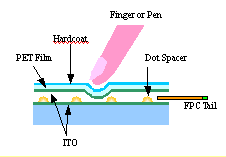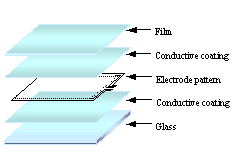IGT Resistive TouchScreen Technology
|
Typical Applications |
| - |
Point of Sale |
| |
Restaurant,
Fast food |
| |
Hotel, Vending
Machine |
| |
Retails,
Grocery
|
|
| - |
Industrial Solutions |
| |
Process
Control |
| |
Machine
Control |
| |
OA Equipment |
| |
Industrial PCs |
| |
R&D Equipment |
| |
FA Equipment
|
|
| - |
Transportation Solutions |
| |
In-vehicle Use |
| |
Baggage Handling
|
|
| - |
Medical
equipment |
| |
 |
|
| - |
Product |
| |
10.4" ~ 19.0" |
| |
Custom size
|
|
| - |
Glass Type |
| |
Normal |
| |
Strengthen
|
|
| - |
Film Type |
| |
Anti-glare |
| |
Clear |
| |
High clear
|
|
| - |
Controller Option |
| |
Serial |
| |
USB
|
|
| - |
Touch Life |
| |
More than 30
million touches
|
|
| - |
Warranty |
| |
Extensive
warranties (5 years) |
|
|
A 5-Wire Resistive touchscreen is coated with a thin
metallic electrically conductive and resistive layer
that causes a change in the electrical current which is
registered as a touch even and sent to the controller
for processing. Resistive touch panels are generally
more affordable but offer only 75% clarity and layer can
be damaged by sharp objects. Resistive touchscreens are
not affected by outside elements such as dust or water.
Generally in the analogue resistive technology, top
layer acts as a probe detecting the other axis(X or Y)
and this structure, as the top layer gets worn out, may
degrade the linearity and the accuracy of detecting
coordinates with long time use. 5-wire resistive
technology is to complement these weak points and here
are its structure and the operating principles.
| As shown above, 5-wire technology utilizes
the bottom substrate for both X & Y axes'
potential measurements. All the electrodes
are placed on the bottom layer and the top
layer acts only as a voltage measuring
probe. This basic design difference of the
structure leads to much more durable and
stable characteristics and it works properly
even with non-uniformity in the top layer's
conductive coating. |
 |
|
Advantages of
5-Wire Resistive |
| - |
Superior accuracy, performance,
durability |
| - |
Finger,
gloved-hand, and pen for data
entering |
| - |
Strong
resistance to external static
electricity and noises in poor
conditions |
| - |
Clean
original images by using films with
excellent transmission |
| |
|
|
|
5-Wire Resistive
Touchscreen Specification
MECHANICAL
Structure:
Sensor Sizes:
Input Method:
Touch Activation Force:
Film Surface Hardness:
Surface Durability: |
PET Film - Anti-Glare type - 188 15% (T)
Clear type - 188 15% (T)
Glass 1.8, 2.9 0% (T)
ConnectorFPC
tail , 5-pin, Pitch=2.54
Tape (Gasket) 50, 80
Controller - Serial, USB
10.4” - 19.0" Custom sizes
Finger, Gloved Finger or Stylus Pen
Less than 110 grams
Meets pencil hardness 3H
10k times (250gf, pen speed 100, 5mm/sec) |
|
OPTICAL
Light Transmission: |
81% (550nm wavelength optimized for flat-panel
displays) |
|
RELIABLILTY
Charter writing operation:
Touch Life: |
5,000,000 alphanumeric characters at any point
within an effective area.
More than 10 million touches in a single
location |
|
ENVIRONMENTAL
Usable Temperature:
Storage Temperature:
Relative Humidity:
Humidity Test:
Thermal Shock Test: |
Operating: -20°C ~ 70°C Humidity 90% RH at max
35°C
Storage: -40°C ~ 80°C Humidity 90% RH at max
35°C
25 ~ 90% Temperature: 20±2°c, Humidity: 65 ± 5%
RH
60±2°C and 90~95% relative humidity
-40°C±2°C/30min, 80°C±2°C/30min (10cycles) |
|
ELECTRICAL
Touch Resolution:
Accuracy:
ITO Glass Resistance between leads:
Chattering Time:
|
1024 x 1024 or more
Standard Deviation of error is less than 2% on
most displays.
Criterion Direction "X" (Glass side) 30~100
(Typ. 350) Direction "Y" (Glass side) 30~100
10msec |
|
|
|





